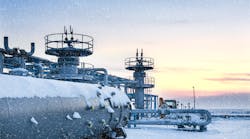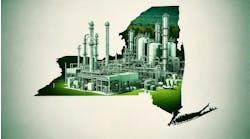A few years ago, I participated in a design review for a gas plant [1]. The process featured a large distillation column in which the design basis included both summer and winter cases — but with operating conditions unchanged. The utility balances, however, showed the cooling water would be 35°F cooler in winter than in summer. This potentially allows the column overhead to operate at significantly reduced temperatures in the winter months by maintaining the cooling water flow rate, but with the water at its seasonally lower temperature.
It’s well-known that lowering the overhead temperature reduces the operating pressure in a distillation column and improves the relative volatility of the materials being separated. This, in turn, decreases the reboiler duty. A secondary effect, which further reduces the energy requirement, often isn’t recognized: As the column temperature goes down, less sensible heating is required to raise the feed to column temperatures. Because the sensible heat is supplied indirectly through the reboiler, this further decreases the reboiler duty.
Following our initial review of the gas plant design, we checked for any constraints that would prevent the column from operating at lower temperatures during the winter — and didn’t find any such constraints. The only changes required in this instance were to update the heat and material balance for the winter case, and to modify the operating instructions. Estimated operating savings were $100,000/yr, with no increase in project cost.
Here, the project team identified the opportunity to exploit seasonality effects at the design stage. Unfortunately, this doesn’t always happen. An operations team at an ethylene plant observed that the cooling water temperature at its site in the summer is 77–86°F, but in winter is 66–72°F. This makes it possible to run condensers at a lower temperature and pressure in winter, as in the previous example. The team reduced the operating pressure of the depropanizer stripper from 100 psig (summer) to 92 psig (winter). This, in turn, dropped the stripper bottom temperature from 176°F to 169°F. Similar reductions were obtained in the depropanizer rectifier pressure and temperature in the winter months.
In the case of the debutanizer at the same ethylene plant, management decided to install an additional condenser — requiring some investment. The new condenser reduced the operating pressure to 39 psig from 46 psig, and the bottom temperature to 216°F from 230°F. This resulted in steam savings of between 2.2 and 4.5 klb/h (depending on plant throughput), worth a minimum of $120,000/yr. The operating pressure of the propylene re-run tower also fell to 235 psig from 294 psig.
However, energy efficiency is only one of the benefits. The reboilers, as well as the lower trays in the depropanizer columns, and almost all of the trays in the debutanizer, are subject to fouling due to thermal and catalytic polymerization of unsaturated hydrocarbons. This necessitates periodic mechanical cleaning. The rate of fouling doubles for every 18°F increase in temperature, so reducing the operating pressures and temperatures decreases the rate of fouling. This significantly lengthens the run time between cleanings, with a corresponding reduction in operating and maintenance costs.
Similar examples exist for other types of equipment, e.g., the ideal gas laws show the power requirement of a compressor is directly proportional to the absolute temperature of the gas. We can achieve lower temperatures in suction coolers and inter-stage coolers in the winter months, thus reducing the compressor power. We also can obtain similar winter savings in steam turbines that use vacuum condensers. Lower condenser temperatures produce deeper vacuums, which, in turn, improve the steam rate in the turbines. These changes also can increase plant throughput, providing even greater financial benefit.
At many sites, it’s standard practice to turn off some cooling tower fans and cooling water pumps in the winter. This is generally presented as an energy-saving strategy, and, of course, it does eliminate some energy consumers. However, I encourage you to look at the big picture. You may get bigger savings by maximizing the seasonality benefits of having a high flow of cold water through some of the equipment elsewhere on your site.
REFERENCE
1. Alan Rossiter, “Energy Efficiency in Capital Projects,” p. 21, PTQ Revamps (Oct. 2015), supplement to PTQ (Q4 2015).



